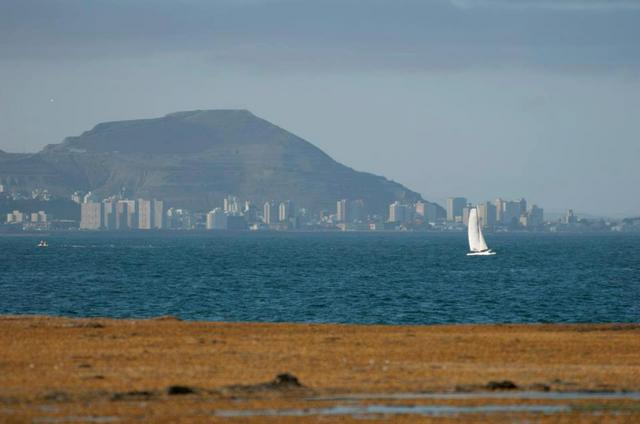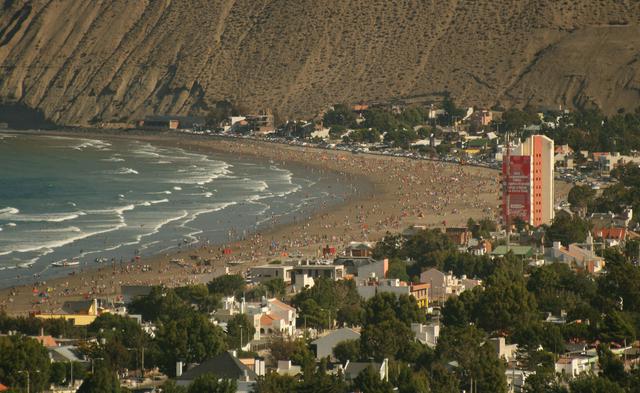Comodoro Rivadavia is the largest city of Chubut province in the Patagonia region in Southern Argentina. The lively city is located at the Atlantic Coast in the south of the province, in a beautiful area of the San Jorge Gulf with many beaches surrounded by hills. It has about 200 000 inhabitants, a university and a rich cultural life.

-nYozR.medium.jpg)
Comodoro Rivadavia, often simply called Comodoro, is the center of one of the most important oil extraction regions in Argentina. Founded in 1901 as a port for the agricultural colony near Sarmiento further inland, the fate of the city changed in 1907 when petroleum was discovered. The wealth of the city has attracted numerous immigrants from all over Argentina, Chile, Bolivia and Peru. It's one of Argentina's most expensive cities to live in, mainly because of high rents. However, for visitors the prices are similar to other Patagonian cities.
The modern city offers very few historical buildings, but has some nice museums and beautiful sights and places to walk. The most interesting area for visitors is the Rada Tilly beach which belongs to an independent town. The northern neighborhoods and suburbs, like General Mosconi, Villa Astra, Caleta Córdova or Diadema Argentina are beautifully located between colorful hills, unfortunately some of the beaches of this area are polluted and swimming is forbidden.
The climate is typical for the Patagonian coastline, with warm summers and cool winters. It is often windy, above all in spring. The best time to visit the beaches is between January and March, as the water temperature until December is chilly.
- Museo Nacional del Petróleo, San Lorenzo 250 (in General Mosconi neighborhood, north of the city center. Tu-F 9:00-17:00, Sa 15:00-18:00. The museum shows machinery from petroleum extraction.
- Museo Ferroportuario, Inmigrantes Gallegos 199. Tu-F 8:00-17:00, Sa Su 15:00-19:00. The museum, located in the former railway station, shows the history of the port and the railway line. It is also a cultural center.
- Museo Regional Patagónico Antonio Garcés, Avenida Rivadavia and Chacabuco. M-F 9:00-18:00, Sa Su 11:00-18:00. The museum tells the history of the city and gives an overview about nature and geology of the region.
Museo Nacional del Petróleo, San Lorenzo 250 (in General Mosconi neighborhood, north of the city center. Tu-F 9:00-17:00, Sa 15:00-18:00. The museum shows machinery from petroleum extraction.
Museo Ferroportuario, Inmigrantes Gallegos 199. Tu-F 8:00-17:00, Sa Su 15:00-19:00. The museum, located in the former railway station, shows the history of the port and the railway line. It is also a cultural center.
Museo Regional Patagónico Antonio Garcés, Avenida Rivadavia and Chacabuco. M-F 9:00-18:00, Sa Su 11:00-18:00. The museum tells the history of the city and gives an overview about nature and geology of the region.
- Climb the El Chenque. hill and get a spectacular view of the city. The hill can be accessed from the Ruta 3 just north of the center or walking through the poorer neighborhoods west of the center (not recommended after dark).
- Visit the city beach. north-east of the center. The water is fresh, particularly in early summer when it has around 15°C, while in February and March it can reach almost 20°C.
Climb the El Chenque. hill and get a spectacular view of the city. The hill can be accessed from the Ruta 3 just north of the center or walking through the poorer neighborhoods west of the center (not recommended after dark).
Visit the city beach. north-east of the center. The water is fresh, particularly in early summer when it has around 15°C, while in February and March it can reach almost 20°C.
The downtown area, mainly the sector north of Avenida Rivadavia and between Francia street and the coastline, offers a wide variety of goods. Prices are comparable with Northern Patagonian cities and lower than in Southern Patagonia, so if you are going further south, it's a good idea to buy your daily needs here.
Despite of the wealth of the city, there is still a lot of poverty in Comodoro Rivadavia, and the high inequality has contributed to a relatively high crime rate. As a visitor, you should be wary like in the large Argentine cities and avoid walking around in poorer suburbs, particularly at night.

- Rada Tilly is home to one of the most beautiful beaches of Argentina. The resort town is located in a small bay surrounded by steep hills. It lies 10 km south of the city and is a separate municipality of about 10 000 inhabitants. The town is quiet, without much nightlife, and visited mostly by Chileans. It is also a popular "bedroom suburb" of Comodoro Rivadavia.
- More beaches are located on the way south alongside the Ruta Nacional 3 to Caleta Olivia. Most of them don't have infrastructure.
- In Sarmiento, about 200 km. inland, you can visit two enormous lakes and petrified woods.
[[Rada Tilly]] is home to one of the most beautiful beaches of Argentina. The resort town is located in a small bay surrounded by steep hills. It lies 10 km south of the city and is a separate municipality of about 10 000 inhabitants. The town is quiet, without much nightlife, and visited mostly by Chileans. It is also a popular "bedroom suburb" of Comodoro Rivadavia.
More beaches are located on the way south alongside the Ruta Nacional 3 to Caleta Olivia. Most of them don't have infrastructure.
In [[Sarmiento]], about 200 km. inland, you can visit two enormous lakes and petrified woods.
